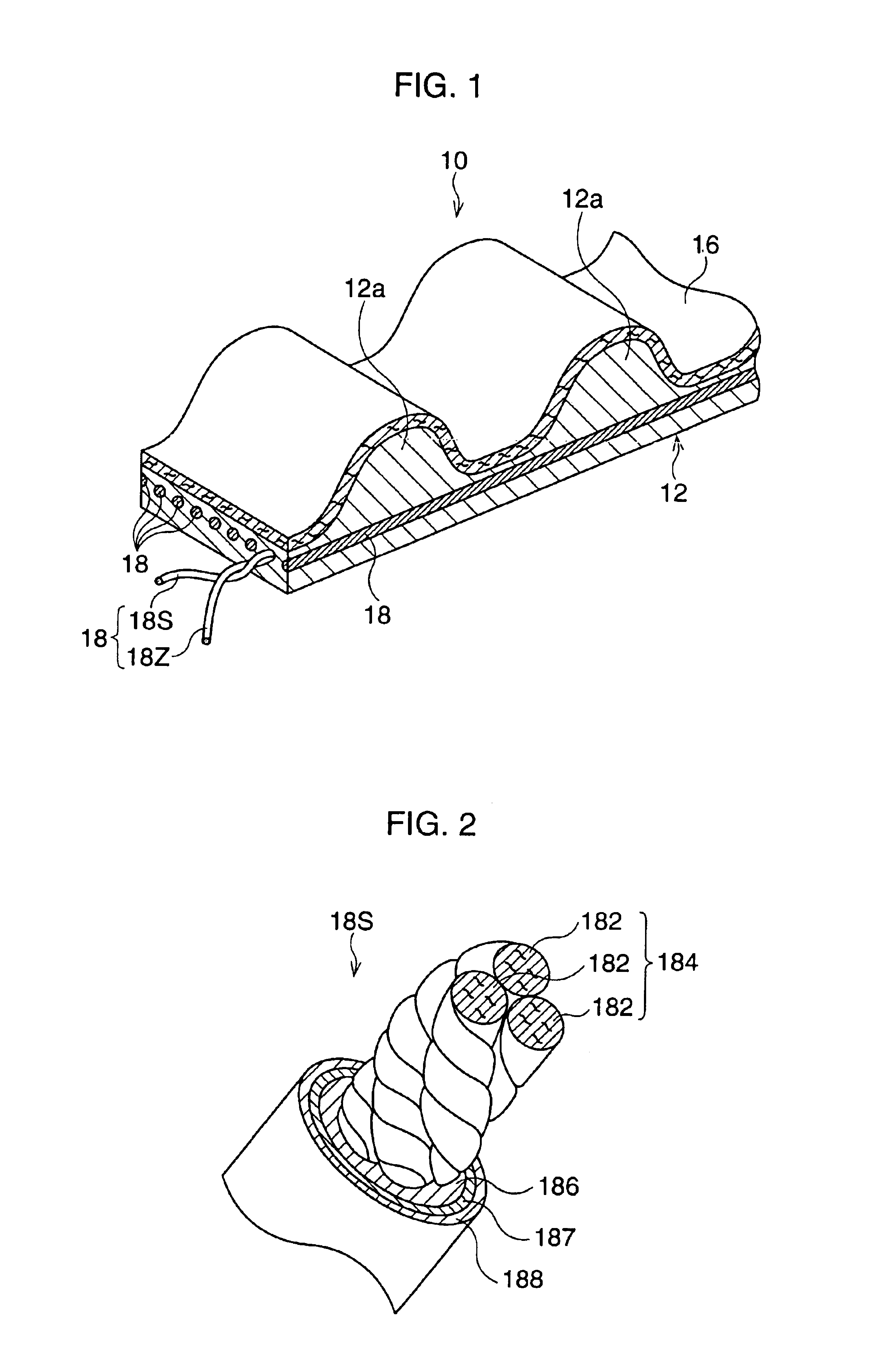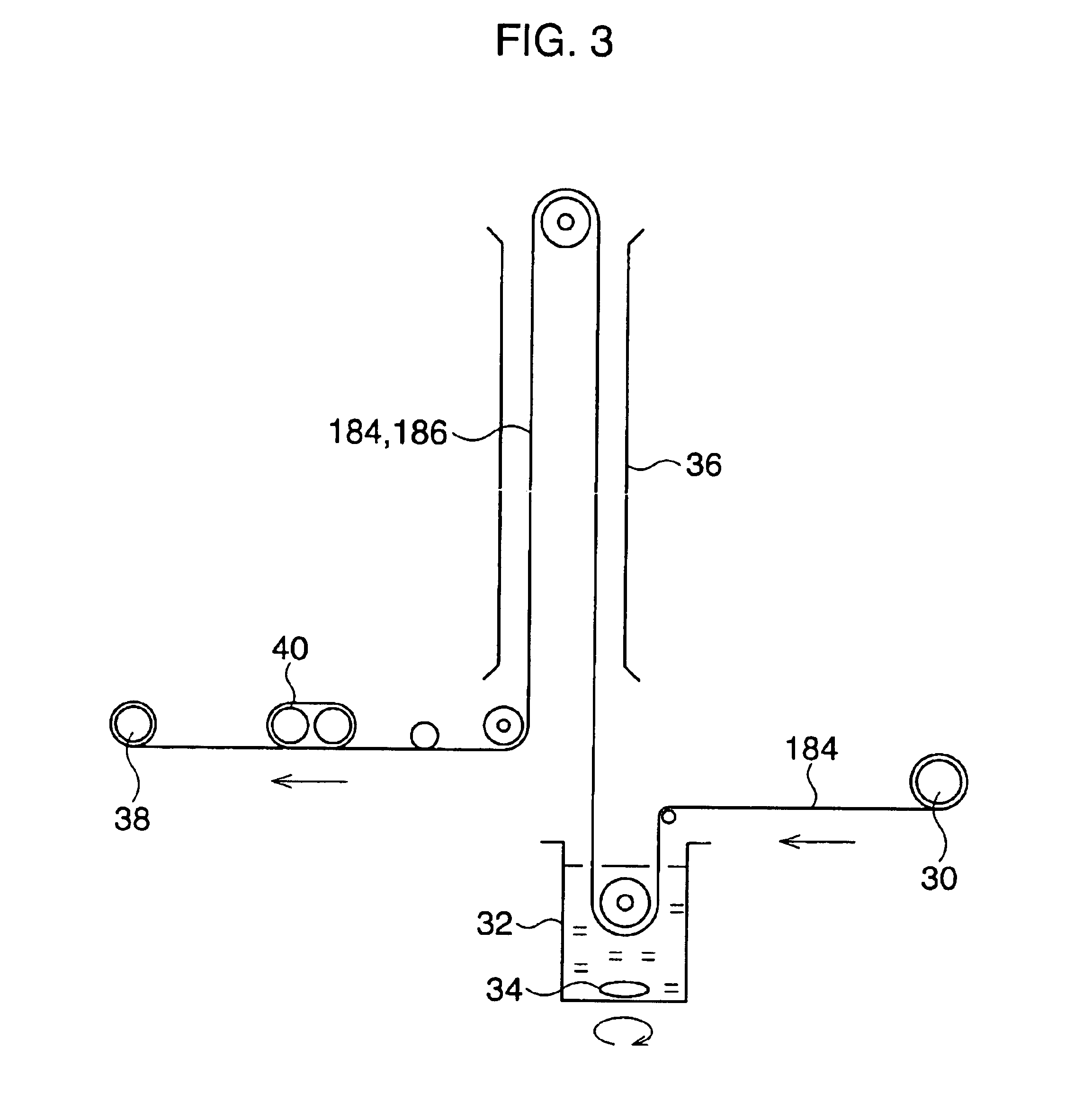Transmission belt and method of treatment for bonding with poly-p-phenylene benzobisoxazole fiber
a technology of polyphenylene benzobisoxazole and transmission belt, which is applied in the field of transmission belt, can solve the problems of poor bondability with rubber cement or rfl adhesive, high crystallinity and close knit structure, and early breakage of toothed transmission belts, so as to improve the strength of transmission belts and improve bondability
- Summary
- Abstract
- Description
- Claims
- Application Information
AI Technical Summary
Benefits of technology
Problems solved by technology
Method used
Image
Examples
example 1
[0048]First, 1000 denier PBO fiber (Zylon AS 1110dtx filaments made by Toyobo Corp.) were given primary twists in the S-direction, and three of the primary twisted PBO fibers were bundled together and a given final twist in the S-direction. The result was used as the yarn cord. The yarn cord was subjected to the primary treatment and secondary treatment by the coater shown in FIG. 3.
[0049]In the primary treatment solution, diglycerol polyglycidyl ether (Denacol EX421 made by Nagase Kasei Kogyo) was used as the epoxy compound, an NBR latex having a latex content of 45 wt % (Nipol NUN5100 made by Nippon Zeon) was used as the latex, and a 10% solution of sodium hydroxide was used as the ring-opening catalyst of the epoxy compound. 2 wt % of diglycerol polyglycidyl ether and 4.44 wt % of NBR latex (solid content 2 wt %) were added to produce a 1:1 ratio of solid content of the epoxy compound and latex, 2 wt % of a 10% solution of sodium hydroxide (content 0.2 wt %) was added to produce ...
example 2
[0059]In Example 2, the test piece 50 was prepared and the bond strength evaluated by the same methods as in Example 1 other than the difference in the ingredients of the primary treatment solution. In the primary treatment solution of Example 2, as shown in Table 1, the content of the epoxy compound was made 5 wt %, the latex 11.1 wt % (5 wt % solid content), and the sodium hydroxide aqueous solution 5 wt %. The amounts were made 2.5 times those in Example 1. The solid content coat at this time was 5 wt % with respect to the yarn, while the bond strength was 110N / 15 mm. The peeling location was confirmed to be the interface between the cords 54 and the rubber sheet 56.
example 3
[0060]In Example 3, the test piece 50 was prepared and the bond strength evaluated by the same methods as in Examples 1 and 2 other than the difference in the ingredients of the primary treatment solution. In the primary treatment solution of Example 3, as shown in Table 1, the content of the epoxy compound was made 5 wt % and latex 11.1 wt % (5 wt % solid content). The amounts were made the same as in Example 2. Further, 2-methylimidazole having a concentration of 10% was used as a ring-opening catalyst of the epoxy compound instead of sodium hydroxide. This was added in the amount of 5 wt % (content of 0.5 wt %) or {fraction (1 / 10)} of the epoxy compound. The solid content coat at this time was 5 wt % with respect to the yarn, while the bond strength was 140N / 15 mm. The peeling location was confirmed to be not the interface between the core cords 54 and the rubber sheet 56, but breakage occurring inside the rubber sheet 56.
PUM
| Property | Measurement | Unit |
|---|---|---|
| wt % | aaaaa | aaaaa |
| temperature | aaaaa | aaaaa |
| melting point | aaaaa | aaaaa |
Abstract
Description
Claims
Application Information
 Login to View More
Login to View More - R&D
- Intellectual Property
- Life Sciences
- Materials
- Tech Scout
- Unparalleled Data Quality
- Higher Quality Content
- 60% Fewer Hallucinations
Browse by: Latest US Patents, China's latest patents, Technical Efficacy Thesaurus, Application Domain, Technology Topic, Popular Technical Reports.
© 2025 PatSnap. All rights reserved.Legal|Privacy policy|Modern Slavery Act Transparency Statement|Sitemap|About US| Contact US: help@patsnap.com



